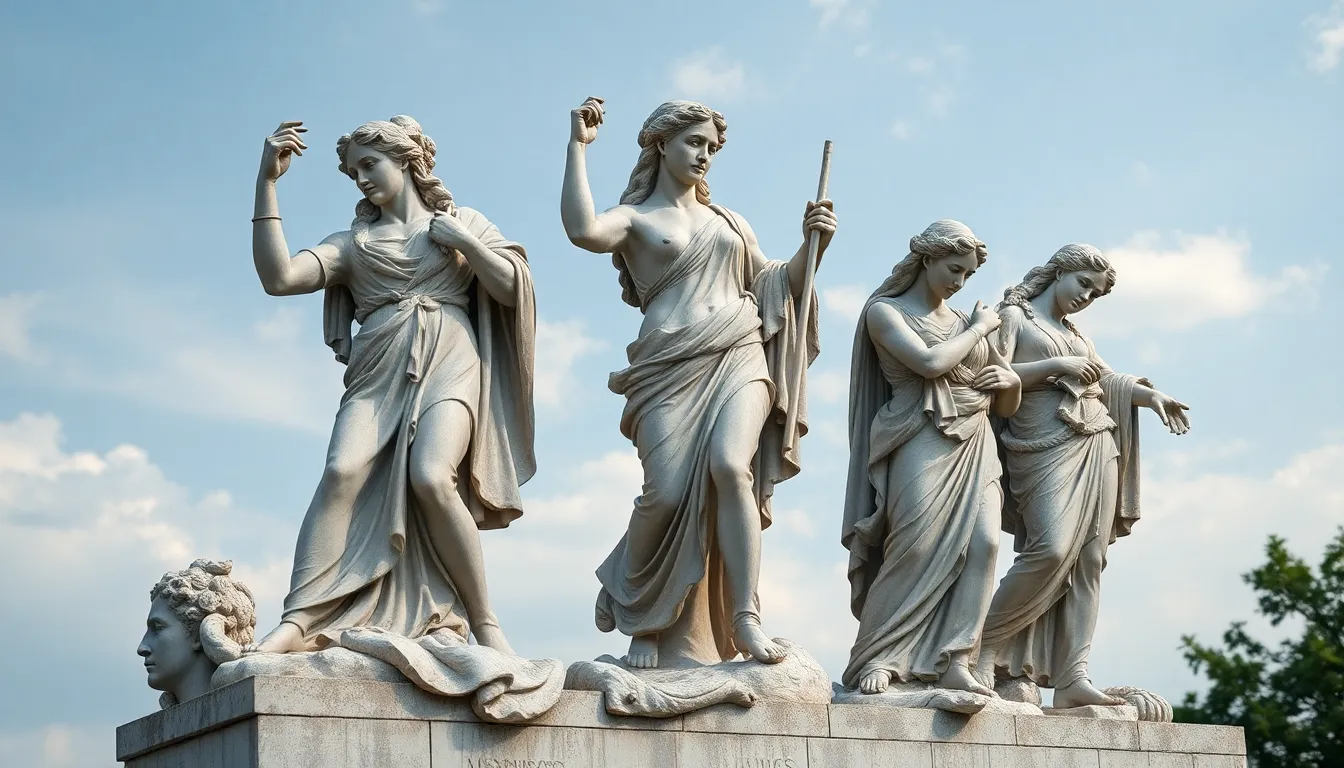The Muses and Their Depictions in Classical Sculpture
I. Introduction
The Muses, in Greek mythology, are the nine goddesses who inspire the creation of literature and the arts. Each Muse is associated with a specific domain of art or science, and they embody the ideals of creativity and intellectual pursuit. Their significance extends beyond mere inspiration; they represent the essence of artistic endeavors and the pursuit of knowledge.
Throughout history, the Muses have played a pivotal role in the arts and sciences, serving as symbols of inspiration for poets, musicians, and scholars alike. This article aims to explore their depictions in classical sculpture, examining how these representations reflect their characteristics and the cultural values of ancient Greece.
II. Historical Context of the Muses
The origins of the Muses can be traced back to ancient Greek culture, where they were worshipped as divine patrons of the arts. Initially, they were associated with specific locations, such as Mount Helicon and Mount Parnassus, which were believed to be their sacred abodes.
Over time, the representation of the Muses evolved in both art and literature. From early poetic references to elaborate sculptures, their forms have been shaped by the changing tides of artistic expression and societal values. The Muses have significantly influenced classical thought, inspiring philosophers and artists to explore themes of beauty, knowledge, and creativity.
III. The Nine Muses: An Overview
The Muses are often depicted individually, each representing a different aspect of the arts and sciences. Here is a brief overview of each Muse:
- Calliope – Muse of epic poetry, often depicted holding a scroll or writing tablet.
- Clio – Muse of history, typically shown with a book or a scroll, symbolizing the recording of events.
- Erato – Muse of love poetry, often represented with a lyre or a wreath of roses.
- Euterpe – Muse of music, frequently depicted playing a flute or with musical notes swirling around her.
- Melpomene – Muse of tragedy, shown with a tragic mask and sometimes a sword, embodying the depth of dramatic art.
- Polyhymnia – Muse of sacred poetry, often portrayed in a contemplative pose, symbolizing reflection and spirituality.
- Terpsichore – Muse of dance, depicted in motion, celebrating the art of dance with grace and fluidity.
- Thalia – Muse of comedy, typically shown with a comic mask and a shepherd’s staff, representing the lighter side of art.
- Urania – Muse of astronomy, often depicted with a globe and a compass, representing the celestial sciences.
IV. Iconography and Symbolism in Sculpture
In classical sculpture, the Muses are imbued with rich iconography and symbolism. Each Muse is associated with specific attributes that help convey her domain:
- Common Attributes: Each Muse carries objects that represent their sphere of influence, such as Calliope’s scroll or Euterpe’s flute.
- Poses and Expressions: The poses of the Muses often reflect their character; for example, Melpomene’s somber expression signifies the gravity of tragedy, while Thalia’s joyful demeanor embodies comedy.
- Drapery and Color: The style of drapery and the colors used in sculptures can indicate the Muse’s emotional state or the thematic elements of the artwork.
V. Notable Examples of Muse Sculptures
Throughout history, several notable sculptures have depicted the Muses, showcasing their enduring appeal in art:
- The Muses of Mount Helicon: These early representations capture the Muses in their natural environment, often surrounded by nature and symbols of inspiration.
- The Muses in the Louvre: A case study of the Louvre’s collection reveals various interpretations of the Muses, demonstrating the evolution of their depiction through different artistic periods.
- Roman Adaptations: The Romans adopted Greek representations of the Muses, often infusing them with their cultural themes and artistic styles.
VI. The Influence of Muses on Later Artistic Movements
The legacy of the Muses extends far beyond ancient Greece, influencing numerous artistic movements:
- Renaissance Interpretations: During the Renaissance, artists revived classical themes, often depicting the Muses as embodiments of humanism and intellectualism.
- Neoclassical Sculpture: In the neoclassical period, the Muses were portrayed with an emphasis on balance, harmony, and ideal beauty, reflecting the values of the time.
- Modern Representations: Today, the Muses continue to inspire artists across various mediums, serving as symbols of creativity and the pursuit of knowledge.
VII. Thematic Analysis of Muses in Sculpture
The Muses serve as powerful thematic symbols in sculpture, representing various aspects of human experience:
- The Intersection of Inspiration and Creativity: The Muses embody the spark of inspiration that fuels creativity, making them central figures in artistic expression.
- Embodiments of Human Aspiration: Each Muse symbolizes a different facet of human aspiration, inspiring individuals to pursue their artistic and intellectual goals.
- Gender Roles: The portrayal of the Muses also reflects societal views on gender, with the female Muses often representing both nurturing inspiration and powerful intellect.
VIII. Conclusion
In conclusion, the Muses hold significant importance in classical sculpture, serving as representations of inspiration, creativity, and the pursuit of knowledge. Their depictions reflect the cultural values of ancient Greece while continuing to resonate in contemporary art and thought.
The enduring legacy of the Muses in art and culture reminds us of the timeless nature of creativity and the human spirit. As we navigate the complexities of modern life, the Muses remain relevant, inspiring new generations to seek beauty, knowledge, and artistic expression.




